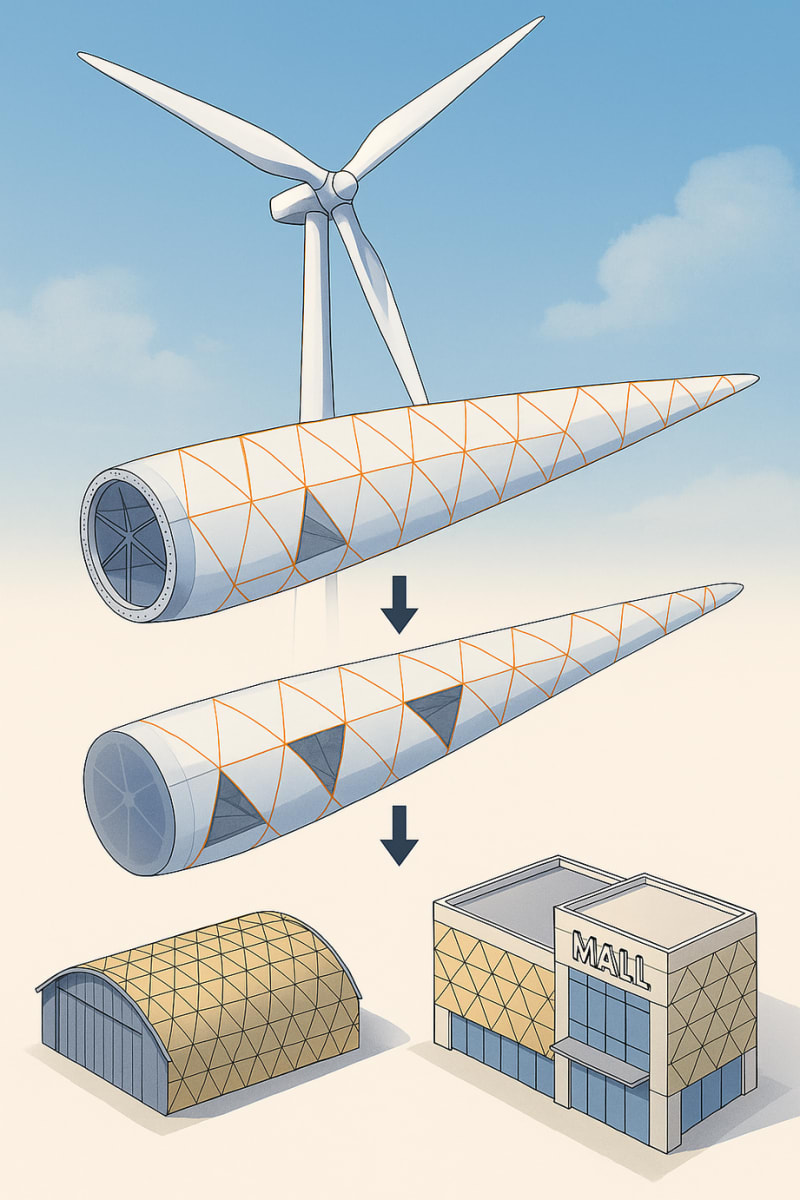Globally, tens of thousands of wind turbine blades are being retired without scalable, sustainable reuse pathways. These blades—built from glass-fibre composites—are often landfilled, incinerated, or shredded into low-grade filler. At the same time, the construction industry is seeking cost-effective, fire-rated façade materials with a lower carbon footprint. This project proposes a transformative solution: a mobile, containerized micro-factory that turns decommissioned turbine blades into architectural façade panels, directly at the site where the blades are replaced with new ones.
The system is deployed as a five-container mobile micro-factory at wind farms or blade storage sites. A full blade is mounted horizontally in a servo-driven rotating chuck fixed to a structural steel frame, with additional resting supports stabilizing longer blades. A LiDAR system scans the blade’s outer shell to generate a detailed 3D surface map, which is used to virtually divide the shell into triangular panels—each no larger than a standard Euro-pallet (≈1.1 × 0.8 m) and optimised for modularity and cutting efficiency. A CNC water jet cutting head, mounted on a gantry that moves longitudinally and vertically along laid rails, follows the mapped layout while the blade is rotated by the chuck, allowing full access to the surface and enabling precise extraction of panels.
These triangles are cut only from the outer shell, carefully avoiding the internal shear web(s) of the blade. Up to 65–70% of the blade surface is recovered as usable material. Panels are extracted using suction cup fixtures, then transferred via a suspended rail system for coating and curing. A cementitious or ceramic-based fire-resistant coating is applied in a self-contained spray booth. For military use cases, such as aviation hangars vulnerable to drone attacks, an elastomeric or shock-absorbing coating may be used instead, increasing blast resistance and reducing panel fragmentation. Each panel receives a laser-etched code that identifies its exact façade position, enabling fast, sequenced installation.
The final product is a lightweight, durable cladding panel suitable for civil and defense applications. A steel or aluminium bracket system allows each panel to attach to conventional façade sub-structures. Some panels interlock structurally, reducing the number of attachment points required. The material’s low thermal conductivity also provides excellent sun-load blocking—helping reduce cooling needs in hot climates.
Each micro-factory can process up to five blades per week, yielding approximately 185 m² of façade panels (based on typical 1 MW-class blades). The estimated production cost is ~£70/m², undercutting traditional aluminum composite panels by 20–40%, with a resale value of ~£90/m².
This design offers a zero-landfill, high-yield upcycling solution for wind blade waste by processing blades directly at wind farms—eliminating heavy transport and reducing emissions. The system uses recirculated water and is fully modular and self-powered. It delivers a closed-loop, scalable manufacturing model—merging clean energy, material science, and automation with strong environmental and commercial impact.
Like this entry?
-
About the Entrant
- Name:Cezar Florescu
- Type of entry:individual
- Patent status:none


